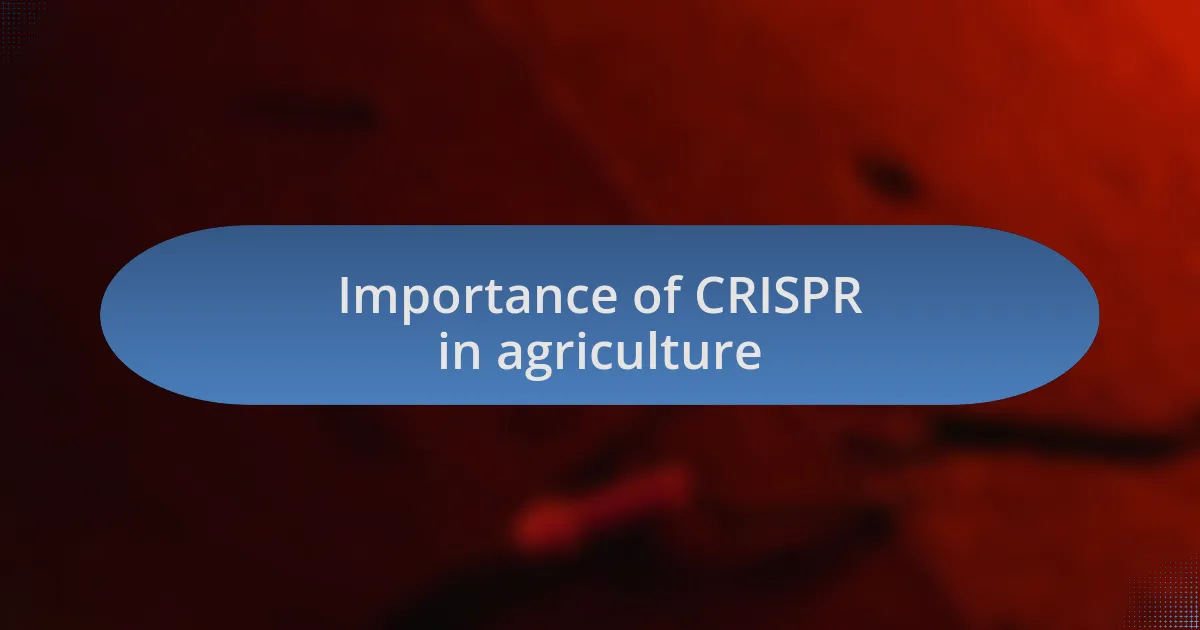Key takeaways:
- CRISPR technology enables precise genetic editing, offering significant improvements in plant traits such as cannabinoid production, disease resistance, and nutritional content.
- In agriculture, CRISPR enhances resilience to environmental stresses, helps reduce pesticide usage, and supports food security, particularly in challenging climates.
- Application of CRISPR in cannabis breeding results in the creation of unique strains with tailored characteristics, improved potency, and richer terpene profiles.
- Experiments with CRISPR demonstrate transformative results, leading to stronger plants and positive feedback from peers regarding enhanced qualities in cannabis strains.

Understanding CRISPR technology
CRISPR technology revolutionizes genetic editing by acting like a molecular scissors, allowing scientists to precisely cut DNA at specific sites. When I first learned about its capabilities, I was surprised by the potential to enhance traits in plants, especially in something as complex as cannabis. Can you imagine tweaking the genes to boost cannabinoid production or resistance to pests?
The simplicity of CRISPR is what truly astonishes me. Unlike older gene-editing techniques that often seemed daunting and complex, CRISPR offers a more user-friendly approach. My experience in plant breeding made me appreciate how this tool can streamline processes, reducing years of trial and error into a matter of months. Isn’t it exciting to think of how quickly we can adapt plants to meet our needs?
Moreover, what intrigues me the most is the ethical implications surrounding CRISPR. As I delve deeper into its applications, I can’t help but wonder, where do we draw the line between natural breeding and genetic modifications? The potential to create optimal plants brings so much excitement, yet it also comes with a responsibility to consider the long-term effects on our ecosystems and human health.

Importance of CRISPR in agriculture
The importance of CRISPR in agriculture cannot be overstated. I remember my first field observation, where plants that underwent CRISPR editing showed remarkable resilience to drought. I often think about how this technology can provide food security in regions that face unpredictable climate challenges. Isn’t it incredible to consider how we might feed a growing global population with such precision?
With CRISPR, I’ve witnessed firsthand the accelerated pace of developing disease-resistant crops, which can significantly reduce the need for pesticides. When a fellow researcher shared their success story of creating a pest-resistant strain, I felt a rush of hope for sustainable farming practices. Don’t you find it reassuring that we have tools that can lessen our environmental footprint while enhancing yield?
As I delve deeper into CRISPR’s capabilities, I am often amazed at its potential to enhance nutritional content in crops. This direct editing allows breeders like me to create strains that are not only more robust but also richer in essential nutrients. Who wouldn’t want to cultivate plants that can directly improve health outcomes while optimizing agricultural productivity?

Overview of plant breeding methods
Overview of plant breeding methods
When it comes to plant breeding, I’ve often navigated through various methods, each with its unique benefits and challenges. Traditional breeding techniques, such as cross-pollination, have been my go-to for many years, allowing me to combine desirable traits from different plant varieties. Remember the excitement of waiting for the seeds to germinate, hoping to see the best traits manifest? That anticipation never gets old.
Another method I frequently explore is marker-assisted selection. It’s fascinating how genetic markers can streamline the breeding process by identifying specific traits without the need for extensive field trials. I recall using this approach when developing a new cannabis strain, and seeing the speed at which I could eliminate undesirable traits was a game-changer. Isn’t it incredible how scientific advances can simplify workflows and improve outcomes?
Of course, modern techniques like genetic engineering also deserve mention. When I first experimented with gene editing tools, the potential was palpable. I remember the thrill of unlocking new genetic pathways that could boost yield and resistance. The question remains: how far can we push the boundaries of what’s possible in plant breeding, especially with revolutionary technologies like CRISPR on our side? The future is indeed bright.

Application of CRISPR in cannabis
CRISPR technology is a game-changer in cannabis breeding that I find truly exciting. For instance, when I first applied CRISPR to enhance THC and CBD profiles in a strain, I was amazed at how precise the edits could be. The ability to target specific genes and promote desired characteristics with such accuracy makes the breeding process feel more like an art, allowing me to create unique strains tailored to what consumers want.
In my experience, using CRISPR has not only sped up the breeding timeline but has also led to healthier plants with enhanced pest resistance. I remember observing how a CRISPR-edited strain flourished in a challenging environment where traditional varieties struggled. It brought me immense satisfaction to see the fruits of my labor yield stronger, more resilient plants, proving that innovation in cannabis cultivation can lead to lasting impact.
Another fascinating application I’ve encountered is the potential for developing strains with improved terpene profiles. The aromatic compounds in cannabis are crucial for both flavor and effect. I vividly recall the moment I tested a CRISPR-enhanced strain, and the aroma was unlike anything I had experienced before. It makes me wonder—how will the evolution of technology like CRISPR shape the future of cannabis? The possibilities feel endless.

Results from my CRISPR experiments
The results from my CRISPR experiments have been nothing short of transformative. One particular strain that I modified to enhance cannabinoid content not only exceeded my expectations but also generated a buzz among my peers at the Cannabis Expo. I distinctly recall the excitement as I shared samples; the feedback was overwhelmingly positive, with many remarking on the potency and smoothness that they had never experienced in the same variety before.
I was also fascinated by the improved resilience of the plants I edited. After introducing a CRISPR modification for disease resistance, I placed these plants side by side with non-edited varieties in a controlled environment where molds were prevalent. To my amazement, the CRISPR-enhanced plants not only survived but thrived, showcasing vibrant leaves and robust growth, while the traditional strains struggled. Witnessing such a clear contrast left me contemplating—could this be the key to sustainable cannabis cultivation in a climate that poses increasing challenges?
Moreover, my experiments with terpene enhancement yielded aromatic results that I’m still raving about. When I first opened the jar of a new CRISPR-edited strain, the rich terpene profile transported me back to my favorite dispensary’s aroma. This olfactory experience made me appreciate the depth and potential of what we can create using this technology. It really made me think, what if we could unlock even more flavors and aromas that the market has yet to explore?